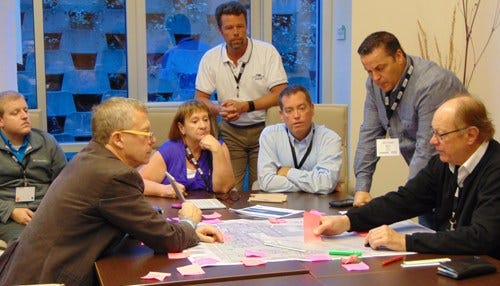Moving Forward Program Takes on New Challenge
 Dan Hellmuth (Hellmuth + Bicknese)
Dan Hellmuth (Hellmuth + Bicknese)
Subscriber Benefit
As a subscriber you can listen to articles at work, in the car, or while you work out. Subscribe NowAn Indiana initiative kicked off in 2015 to develop energy efficient affordable housing in conjunction with transportation solutions is tackling the problem of generational poverty in its second phase. The partner agencies behind Moving Forward believe the right project execution will do more than alleviate current impediments to low-income families; it will change their futures.
The Moving Forward program was designed to create an intersection of affordable, energy-efficient housing and personal transportation. The two proposals chosen in the original phase are successfully underway in Fort Wayne and Bloomington, utilizing the plan’s early ideas for built environments in locales that support ease of access to necessary services. For 2016, the primary agency behind the program, the Indiana Housing and Community Development Authority, wanted to raise the bar.
“Those two teams have really taken on some complex issues when it comes to integrating all of these elements. Having everyone at the table to share their expertise before we even had sites chosen or buildings designed was really innovative in all of this,” explains Jacob Sipe, executive director of IHCDA. “What we recognized when we wanted to do this again was that there was a greater opportunity for us to look at generational poverty, and how we can use housing to break that cycle. We asked Indiana’s community action agencies if they’d like to partner on Moving Forward 2.0 to do that, and the response was overwhelming.”
The two proposals chosen from the submissions throughout the state are the Area IV Agency on Aging and Community Actions Programs, based in Lafayette, and Community Action of Greater Indianapolis. Teams from the groups recently met for a two-day Innovation Workshop to hash out early plans and brainstorm new ideas.
“It was an amazing group that came together, to hear the conversations that architects were having with those working on the poverty side, and listen to those that have a passion for career development and providing early childcare working with someone talking about net-zero buildings,” says Sipe.
CAGI president Edgar Tipton, Jr. is excited about his agency’s involvement and says CAGI’s development plan will dovetail with the federal government’s designation of a Promise Zone on the Indianapolis eastside.
“We have on our team a great developer who’s doing a lot of affordable housing in the Indianapolis area. We also have the superintendent of Indianapolis Public Schools. We have the John H. Boner Center in the area where we’ll develop the project, and we’ll be working with kids, trying to be able to access a school that’s very close to them.”
The Area IV project takes on the added element of applying the Moving Forward mission in a rural setting. The agency’s executive director, Elva James, says her team is working to find a location in the service area that will help meet the mission criteria.
“The purpose is to take a next step beyond poverty,” she explains. “People can get a job, but sometimes they’re one paycheck away from being back in poverty. This will provide next steps to be able to maintain their lift out of poverty.”
James’ team is looking for a site that might lend itself to adaptive reuse, such as an unused school or former medical facility. The agency’s reach is broad, serving Carroll, Clinton, White and rural Tippecanoe counties, but James hopes a building partner will come forward with at least a partial donation to help offset the cost and get the development off to a strong start. In addition to serving residents, she sees the project as benefitting the community at large through education, childcare and wellness programs.
The IHCDA’s key partner in the project is Indianapolis-based Energy Systems Network, which conceptualized the program and provides the chosen developers with access to some of the leading experts in energy, design and finance from Indiana and around the country. Under the program, the two development teams will be able to submit Rental Housing Tax Credit applications of up to $750,000 each, once their development concepts are complete.
Both the Area IV and CAGI programs hope to have acquired their properties and broken ground on their projects by the fall of 2017.
IHCDA’s Sipe explains the decision to take on an additional challenge with the Moving Forward program.
